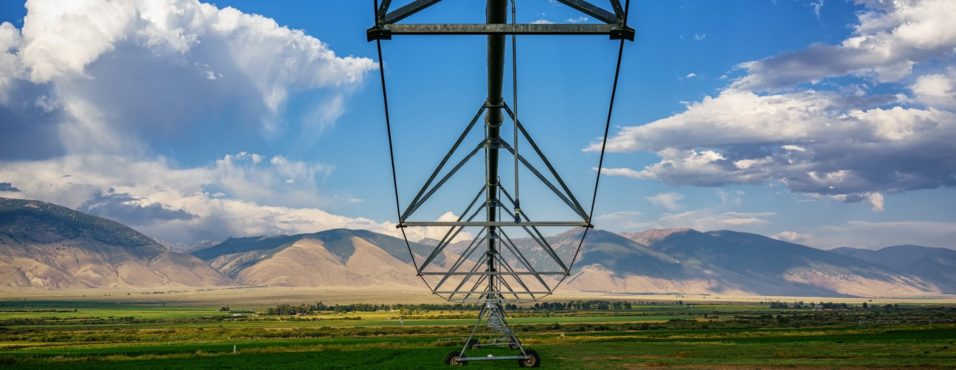US agriculture decreased its overall water use from 1995 to 2010 because of changes in farming practices, as well as changes in domestic food demand and global supply chains.
Decline in Agricultural Water Withdrawals
Will there be enough water to produce food for burgeoning populations as climate change disruptions amplify water stress? This question looms large for agriculture.
In a recent study, “What Factors Drive the Changes in Water Withdrawals in the US Agriculture,” University of Illinois authors assessed US water withdrawals in agriculture and food production from 1995 to 2010, and discovered an 8.3 percent decline in water for crops and a 14 percent reduction for livestock. Across all agricultural activities, there was a slight decline in overall water use.
The decrease was due to multiple factors, including the greater deployment of more efficient irrigation systems, the change in crop selection (including genetically modified crops), and lower per-capita incomes that pushed demand from beef to chicken and pork.
The drop in agricultural withdrawals is significant. In the United States, farming and livestock withdraw the second largest quantity of water, (behind withdrawals for electricity generation), primarily for irrigation. Irrigation plays a heavy role in agriculture’s high yields, particularly in the western US, as irrigated farming accounts for around half the total value of American crop sales. Add in food processing and manufacturing, and about one-third of US water withdrawals of surface water and groundwater in the United States goes to food and agriculture.
Water Trends for Food and Farms
A number of large-scale water-use trends were revealed in the study, like the reduction in water withdrawals for meat production. Drivers included lower incomes that coincided with the Great Recession and led people to eat less meat and choose less expensive cuts of meat. Beef is the most expensive meat, and demand fell while prices rose during the economic downturn.
The move away from beef deepened a longstanding consumer trend. According to co-author, Sandy Dall’erba:
There has also been a shift in consumer demand from red meat to white meat in the US. People consume less beef and more chicken, which require 3.5 times less water per pound of production. Those trends in consumption and taste have helped the US reduce water use for livestock by 14 percent.
Interestingly, meat consumption in the United States climbed to record highs in 2018, then, in 2020, the sharp recession caused by the coronavirus pandemic crimped meat sales. This again demonstrated the connection between economics and meat demand, with production bottlenecks compounding supply problems as COVID-1 outbreaks forced meat processor shut downs.
The comprehensive study examined 18 primary factors that influence water withdrawals for eight crops, six livestock types and 11 food manufacturing industries. The researchers drew on US Geological Survey (USGS) data from the international supply-chain database, Exiobase. The study “included water that’s embedded into the production at all stages of the domestic and international supply chain, from crops and livestock to processed food production — highlighting the interconnectedness of global agribusiness.”
Other trends and drivers were discovered. Water use decreased for many crops like cereal grains, fruits and vegetables because of greater use of efficient irrigation systems. Demand for fruits and vegetables decreased in 2005-2010 during the Great Recession. Other crops, like oilseed, jumped by a whopping 98 percent. During those 15 years, oilseed crops became a greater export commodity where it was sold abroad to places like China and the European Union for processing. Such changes show how consumer demand and production tweaks shape water use patterns along supply chains, from the local to the global level.
Water Use Data Matters
An interesting methodological note is the study’s use of USGS data on irrigation water instead of blue water footprint data from Mekonnen and Hoekstra, whose research is affiliated with the Water Footprint Network (WFN). The WFN values are estimated from crop water-use models and averaged over a period from 1996 to 2009, while the USGS data are based on the US Department of Agriculture Farm and Ranch Irrigation Survey. Since the authors looked only at water withdrawals for farming and food manufacturers, this research didn’t fit within the water footprint scope of evaluating water consumption. Further, Dall’erba et al. didn’t account for the water consumption of rainfall and soil moisture (green water footprint) or water consumption associated with pollution (grey water footprint).
As Dall’erba et al. observe, researchers should compare WFN data with other water use datasets that are collected at local, regional and national levels. The problem is that those datasets are not often available. Thus the development of more reliable data at all levels can help growers fine-tune water-use data reporting and allow for methodologies to paint a clearer picture of how water is actually used on the ground. There’s always room for improvement in data collection and distribution with the notion that farmers, food producers and water managers can better understand how to use water more productively in the increasingly turbulent times ahead.
Written by Kai Olson-Sawyer. Image: Idaho, United States, courtesy of Vidar Nordli-Mathisen on Unsplash.

